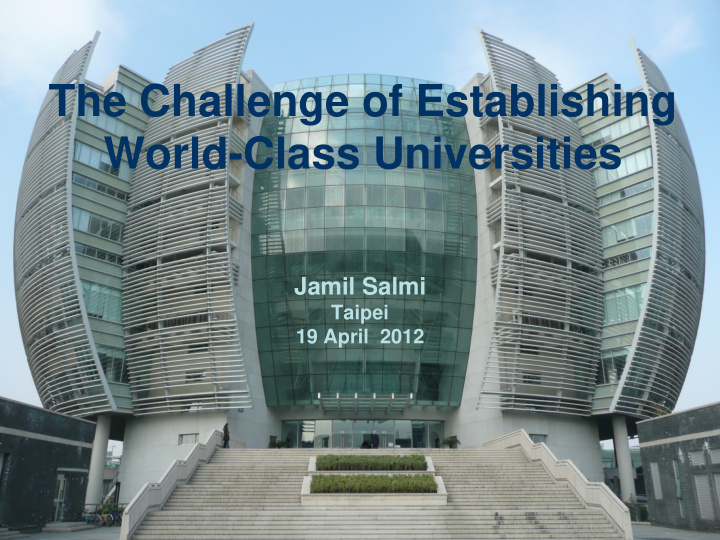



The Challenge of Establishing World-Class Universities Jamil Salmi Taipei 19 April 2012
2
3
defining the WCU • self-declaration • reputation • rankings 4
5
6
top 50 universities (2011) ARWU THES ARWU THES 2011 2011- -12 12 2011 2011
Characteristics of a World-Class University Alignment of Key Factors Concentration of Talent Students Teaching Staff Researchers Top Leading-Edge Graduates Research WCU Supportive Abundant Regulatory Favorable Framework Public Budget Resources Resources Governance Endowment Revenues Autonomy Dynamic Tuition Fees Academic Freedom Knowledge & Research Grants Technology Leadership Team Strategic Vision Transfer Culture of Excellence Source: Elaborated by Jamil Salmi
concentration of talent • teachers and researchers • incoming students • undergraduate / graduate students balance 9
weight of graduate students Share of Undergraduate Graduate University Graduate Students Students Students (%) Harvard 7,002 10,094 59 Stanford 6,442 11,325 64 MIT 4,066 6,140 60 Oxford 11,106 6,601 37 Cambridge 12,284 6,649 35 LSE 4,254 4,386 51 53 Beijing 14,662 16,666 Tokyo 15,466 12,676 45 10
concentration of talent • teachers and researchers • incoming students • undergraduate / graduate students balance – but involving undergraduate students in research • international dimensions 11
international dimensions • foreign faculty – Caltech (37%), Harvard (30%), Oxford (36%), ETH Zürich (60%) • incoming faculty • foreign students – Harvard (19%), Cambridge (18%) 12
international dimensions • reliance on Diaspora (Pohang, HK, SJTU) • English language (all or many) • foreign or foreign-trained academics 14
abundant resources • dependence on government funding – US able to spend 3.3% of GDP ($54,000 per student) – 1/3 public 2/3 private – Europe (E25) only 1.3% ($13,500 per student) • endowments 15
16
Comparison of US and UK Endowment Levels Endowments Endowment US Institutions Assets UK Institutions Assets (2009 million $) (2009 million $) Harvard University 25,662 Cambridge 6,327 Yale University 16,327 Oxford 5,767 Stanford University 12,619 Edinburgh 264 Princeton University 12.614 Manchester 204 University of Texas 12,163 Glasgow 164 17
Comparison of US and UK Endowment per Student Endowment Endowment US Institutions per student UK Institutions per student (2009 $) (2009 $) Princeton University 1,667,000 Cambridge 343,934 Yale University 1,408,000 Oxford 283,670 Harvard University 1,209,000 Edinburgh 9,298 Stanford University 824,000 Glasgow 6,952 University of Texas 239,000 Manchester 5,208 18
abundant resources • government funding • endowments • fees • research funding 19
funding features • 8 out of 11 are public institutions • endowments – Pohang: 2 billion $ – NUS: 1 billion $ – Monterrey Tech: 1 billion $ – SJTU 120 million $ 20
funding features • difficulty to mobilize alumni funding for new universities • elements of public-private partnership (Pohang, HK, Monterrey, Catholic of Chile) 21
22
favorable governance • freedom from civil service rules (human resources, procurement, financial management) • management autonomy – flexibility and responsiveness with power to act • selection of leadership team • independent Board with outside representation 23
U of Chile vs. Catholic U of Chile • HR policies • procurement • fund raising 24
U. Of Malaya vs. NUS – talent • UM: selection bias in favor of Bumiputras, less than 5% foreign students, few foreign professors • NUS: highly selective, 43% of graduates students are foreign, many foreign professors 25
U. Of Malaya vs. NUS (II) – finance • UM: $385 million, $14,000 per student • NUS: $1 billion endowment, $1,200 million, $39,000 per student 26
U. Of Malaya vs. NUS – governance • appointment of VC highly political in Malaysia: 10 VCs until 2008 (Prime Minister statement) • more professional in Singapore (5 VCs) • UM: restricted by government regulations and control, unable to hire top foreign professors • NUS: status of a private corporation, able to attract world-class foreign researchers – 52% of professors (9% from Malaysia) – 79% of researchers (11% from Malaysia) 27
Research Institute in Singapore 28 creating the Solar Energy
outline of the presentation • defining the world-class university • the road to academic excellence 29
the path to glory • mergers • upgrading existing institutions • creating a new institution 30
mergers approach • China, Russia, France, Denmark, Finland, Ireland • potential synergies – 1+1=3 • clash of cultures 31
upgrading approach • less costly • challenge of creating a culture of excellence • focus on governance 32
Recommend
More recommend